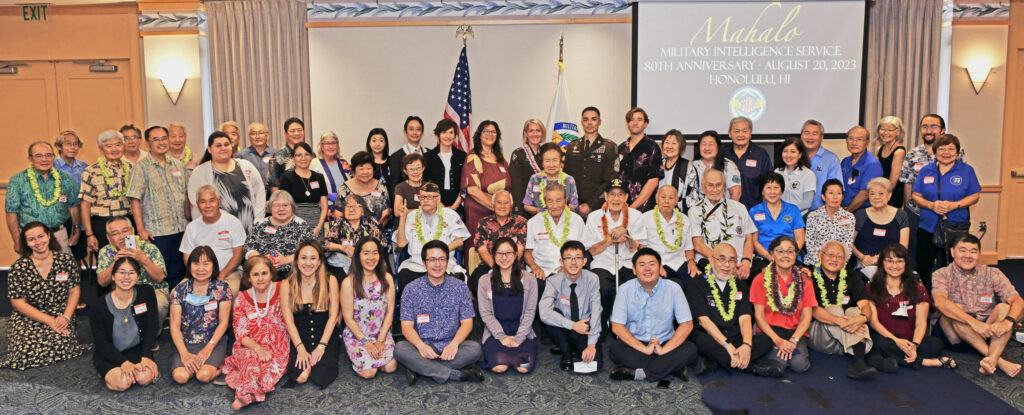Join Us
If you’re interested in perpetuating the legacy of the MIS veterans, please join the MIS Veterans Education Society of Hawaiʻi.
Complete the application and mail it along with annual dues of $20.00 made out to: MIS Veterans. Please mail to:
MIS Veterans Hawai‘i
PO Box 3021
Honolulu, Hawai‘i 96802
MIS Veterans – Hawai‘i Membership-Form

Donate to the Club
The MIS Veterans of Hawai‘i welcomes donations from the members and anyone interested in preserving the legacy of our veterans and supporting the organization’s activities. Please make donations to: MIS Veterans. Donations may be mailed to:
MIS Veterans Hawai‘i
PO Box 3021
Honolulu, Hawai‘i 96802
We welcome your contributions. Thank you.
Help Keep the MIS Legacy Alive
Here are five ways you can keep the MIS legacy alive.
1. Learn your family’s story
You videotaped your kid’s graduation and your grandchild’s birthday. You can record your veteran’s recollections. At least write key facts down and save your notes. Record the dates and locations of photos and especially the names of people in photos.
2. Save wartime letters, documents, photographs, and memorabilia
Each of them is irreplaceable. Efforts are under way to develop permanent storage for these priceless items, by the MIS Veterans Club and the Nisei Veterans Legacy Center. Meanwhile, store them in acid-free containers and away from direct sunlight or extreme temperatures and humidity.
However, if you don’t have storage space or are desperate to discard items, please contact us for advice or assistance.
3. Do some homework
The MIS story is not a simple one because the number of wartime assignments they had were as diverse as the soldiers themselves, and their achievements were cloaked in secrecy. But you can begin with something as effortless as a Google search; enter the veteran’s name along with a keyword like “Army,” “World War II,” or “military intelligence service,” and see what comes up.
Several books have been written about the MIS, many more about the war. Reading can give you a better understanding of what your veteran did during the war. Maybe you can write a book someday, because much remains unrecorded for history.
If you believe a person served in the MIS during World War II, then it is vital to have that person’s military record, particularly the War Department AGO form 53-55 Record and Report of Separation or the later DD-214.
This record will usually indicate the veteran’s military occupation, training and assignments, and his/her decorations and awards. The one-page record may be incomplete, especially because of the secrecy of intelligence work and the often-temporary, unrecorded nature of MIS assignments. Each veteran received a copy of this record upon discharge from service, and would have been required to provide a copy in order to receive veteran’s benefits or burial.
You may also request a veteran’s records from the National Personnel Records Center at
https://www.archives.gov/personnel-records-center/military-personnel
As noted there, a deceased veteran’s next of kin may request the records on line. All others must apply in writing with a Standard Form 180. Success is not assured. A fire at the archives in St. Louis in 1973 destroyed millions of pages of records. In addition to the standard service record, a veteran’s file might have included pay and medical records, individual citations and commendations, and other information. And all of it might have been lost in that fire.
There may be other places that have the records you’re seeking. Veterans discharged in Hawai‘i after World War II, for example, were advised (but not required) to file a copy of their service record with the Territorial Bureau of Conveyances (now a unit of the Hawai‘i Department of Land and Natural Resources). Some did; many did not.
In addition, a handful of MIS veterans and the Japanese American Veterans Association have spent many years compiling a registry of soldiers who attended the MIS Language School or served in the MIS during the war in the Pacific. That registry is constantly being refined and attempts to provide each veteran’s name, serial number, hometown, and assignment. But the data is still incomplete. You might also check some of the books listed in this website’s bibliography. Books such as Harrington’s Yankee Samurai and McNaugton’s Nisei Linguists are indexed, so if a veteran is mentioned in them, the name will appear in the index. And McNaughton’s book is available online at
https://history.army.mil/html/books/nisei_linguists/index.html
The MIS Veterans of Hawai‘i does not have a permanent home and does not maintain individual veterans’ records. There are also commercial websites that offer military records. We have not used them and so cannot recommend for or against them. Best bet is to begin your search at home.
4. Set the record straight
For more than twenty years, a number of independent researchers have been compiling a database containing the service information of MISers who served in World War II, the Battle of Okinawa, and the occupation. Unfortunately, due to the secrecy of the assignments of the MIS personnel, about 2,000 Hawai‘i MIS veterans have incomplete records. This does not do justice to their service.
For the sake of all of your families, your historical legacy, and for the education and appreciation of future generations, volunteers are being recruited to help in this research, which will be conducted entirely in Honolulu. Training will be provided; hours are flexible (weekdays, business hours) and record-copying expenses furnished. Service learning credit may be awarded to qualifying students.
Contact us at misveteranshawaii@gmail.com to help.
5. Join the MIS Veterans of Hawai‘i and get involved
Veterans and their descendants are eligible for membership. Fill out an application to join.
The club does not have a paid staff, nor resources to conduct detailed research. Participation in club events, however, might steer you to people and source material.

